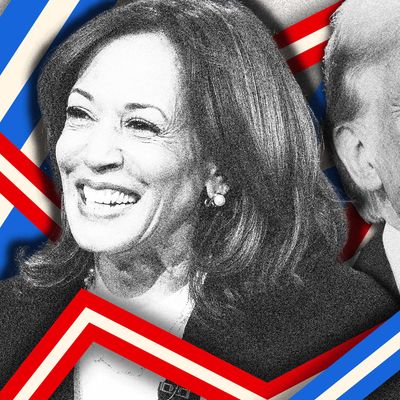Last Trump vs. Harris Polls Present It’s All the way down to the Wire


Photograph-Illustration: Intelligencer; Images: Getty Photos
Two days earlier than Election Day, an estimated 75 million votes have already been forged within the presidential race between Kamala Harris and Donald Trump. It’s attainable the polls are improper. Polling analysts, who’ve various strategies of averaging polls, have barely completely different takes on the race. However with out splitting hairs, it’s laborious to see this as something apart from an extremely shut race the place late turnout traits and polling errors wind up telling us what we can’t know proper now: the id of the forty seventh president.
In nationwide polling averages, Kamala Harris leads by 1.0 % per FiveThirtyEight; 0.9 % per Nate Silver; 2 % in response to the Washington Publish (which rounds numbers) and one % in response to the New York Occasions (which additionally rounds numbers). RealClearPolitics, which in contrast to the opposite shops doesn’t weigh polls for accuracy or modify them for partisan bias, exhibits Trump main nationally by 0.3 %.
Whereas nationwide polls may also help us perceive traits and underlying dynamics, largely as a result of they have a tendency to have bigger samples, the truth that they’ve been so very shut for weeks if not months suggests they will’t inform us who will really win. The most effective we are able to do is extrapolate, primarily based on the connection between the nationwide well-liked vote and the electoral vote depend in earlier election. It makes Democrats nervous to see Harris main Trump by below 2 % within the nationwide polls as a result of Hillary Clinton misplaced in 2016 whereas profitable the nationwide well-liked vote by 2.1 %, whereas Joe Biden barely received in 2020 regardless of profitable the favored vote by 4.5 %. However we do not know if Trump will once more have an Electoral Faculty benefit, and in that case how giant it could be. (Harris would possibly really carry out higher within the Electoral Faculty than within the well-liked vote, as Barack Obama did in 2012.) And whereas we don’t understand how polling errors will reduce, it does appear the total high quality of polls this 12 months is larger than in current presidential elections.
So it’s a greater thought to give attention to polls within the seven battleground states. However they too are loopy shut total. You’ll be able to establish leaders in all seven in the event you get all the way down to fractions. FiveThirtyEight at present exhibits Trump main in 5 of these seven states (Arizona, Georgia, North Carolina, and Pennsylvania), however by lower than a degree in Nevada and fewer than a half-point in Pennsylvania. Harris leads in Michigan and Wisconsin, however once more, it’s by lower than one % in each. The rounded battleground state numbers within the New York Occasions averages exhibits six of the seven battleground states inside a single level (all of them apart from Arizona, the place Trump’s up by three factors).A one % uniform swing might give Harris 308 electoral votes or Trump 312 electoral votes. The Washington Publish’s battleground-state averages make the identical level in a barely completely different approach. They present Harris main in 4 states (Michigan and Wisconsin by 2 %; Nevada by one %; and Pennsylvania by lower than one %) and Trump in three (Arizona and Georgia by two %, and North Carolina by one %). However then the Publish makes this significant statement: “Each state is inside a normal-sized polling error of three.5 factors and will go both approach.”
Each nationwide and state polls recommend that the dynamics of the Harris-Trump contest stay moderately clear.
On the problems, Trump could be very robust with voters who care most about immigration and continues to guide in most polls (although by shrinking margins) amongst voters centered on the economic system. In the meantime, Harris has a giant lead amongst voters fearful about abortion rights. In the event you begin with the Biden-Trump divisions within the citizens from 2020, Harris has improved the Democratic efficiency amongst college-educated white voters, whereas Trump has improved the Republican efficiency amongst Black and Latino voters. Unsurprisingly, this places a small thumb on the scales for Harris within the states with comparatively low nonwhite voting blocs (e.g., Michigan, Pennsylvania, and Wisconsin), and helps Trump in Solar Belt states like Arizona, Georgia, Nevada, and North Carolina. However there are some contradictory undercurrents, with the Harris marketing campaign working laborious to carry Black males again into her column, whereas Trump’s complete get-out-the-vote technique relies on mobilizing low-propensity voters from his core demographic teams (particularly non-college-educated white voters). The numerous response this week of opinion leaders to slurs about Puerto Ricans (a essential swing demographic in extraordinarily shut and pivotal Pennsylvania) provided up by a comic at Trump’s wild New York Metropolis rally exhibits that campaign-trail occasions can nonetheless have an effect on the result.
The ultimate battleground state polls from the extremely influential high-quality New York Occasions-Siena outfit reinforce the undercurrents and the perils of assuming a Blue Wall-Rust Belt division within the Electoral Faculty:
Arizona: Trump +4
Georgia: Harris +1
Michigan: Trump +1
Nevada: Harris +3
North Carolina: Harris +3
Pennsylvania: Even
Wisconsin: Harris +3
A very odd twist within the late polls got here from the ultimate Des Moines Register/Mediacom Iowa Ballot from famend pollster Ann Selzer displaying Harris main amongst probably voters in that not too long ago very crimson state by three factors. Whereas Iowa turning blue in an election this shut can be mind-blowing (Trump carried it by 9 % in 2016 and eight % in 2020), it might if correct sign a regional development in direction of Harris that may lengthen to midwestern battleground states like next-door Wisconsin.
It’s a good suggestion to control late-breaking polls throughout the remaining days of a marketing campaign, and to attempt to not get too distracted by probably deceptive information factors and claims. There’s loads of scrutiny of early voting traits, for instance. However except for reflecting a normal drop in voting by mail because the pandemic election of 2020, and the efforts of Republicans to encourage early in-person voting specifically by their partisans, it’s laborious to know what the numbers imply since most early voters would in any other case be voting on Election Day and Democrats are usually comparatively “late” early voters. A few of the previous dependable indicators of presidential-election outcomes are of restricted use. Sure, the president’s job-approval ranking is at present at a horrible 38.9 % (per FiveThirtyEight), however then Kamala Harris has executed a fairly good job of presenting herself as a “change” candidate regardless of her personal incumbency. And sure, Harris has a small however regular benefit over Trump in private favorability (FiveThirtyEight has her ratio at 46.3 per cent favorable to 47.9 unfavorable, whereas Trump’s is 43.5 % favorable to 52.1 % unfavorable), however so did Hillary Clinton in 2016.
In the event you needed to choose a possible winner at this level, the official forecasters lean towards Trump by the narrowest of margins (Choice Desk HQ has Trump at a 54 % likelihood of profitable; FiveThirtyEight has him at 53 %; and Nate Silver offers Trump a 52 % win likelihood, and the Economist offers him a 51 % probability of profitable. It actually couldn’t get a lot nearer. Larry Sabato’s Crystal Ball expresses contradictory “intestine emotions,” citing traits favoring Trump however noting a way of déjà vu from 2022 that favors Harris.
In different phrases, it’s happening to the wire.





